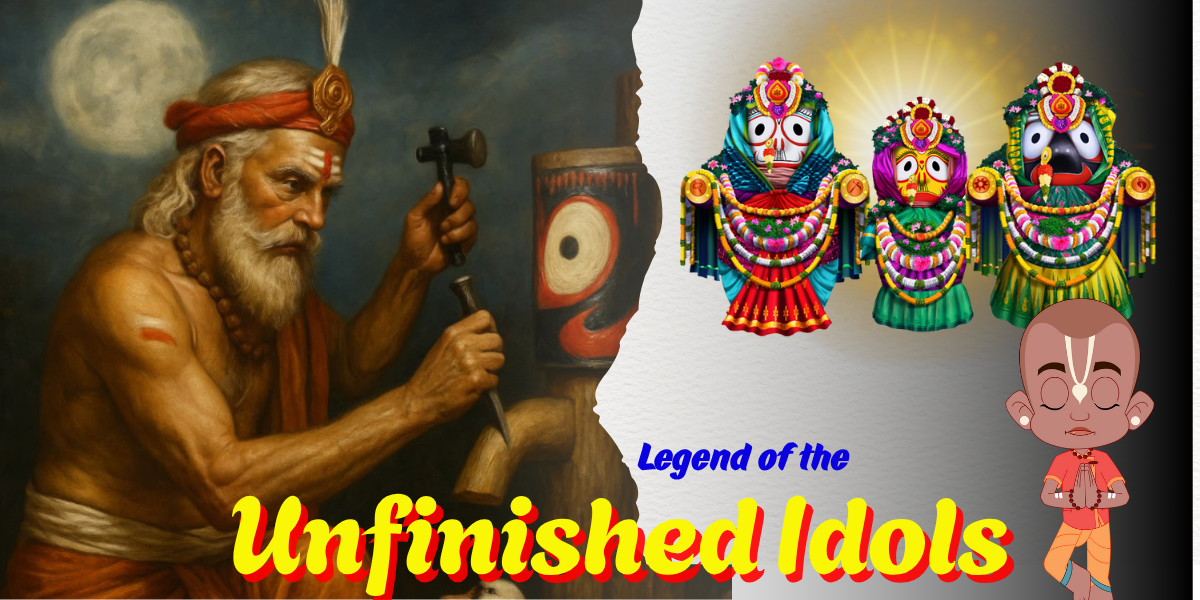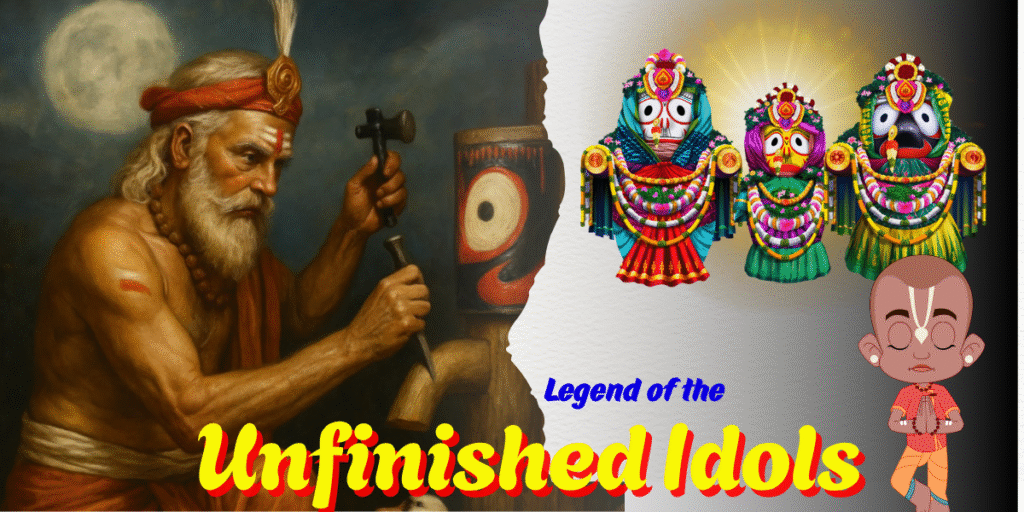
The Legend of the Unfinished Idols: Vishwakarma’s Silent Exit
The Legend of the Unfinished Idols: When Vishwakarma Left Midway
Legend of the Unfinished Idols, in the sacred town of Puri, where the air echoes with the chants of “Jai Jagannath”, lies a tale shrouded in mystery, devotion, and divine intervention — the legend of the unfinished idols of Lord Jagannath, Balabhadra, and Subhadra. It is a story where human impatience meets celestial craftsmanship, and where the divine plan unfolds beyond human understanding.

A Royal Vision and Divine Dream
The story begins with King Indradyumna, the pious ruler of the Malwa kingdom, who had a divine dream. In this dream, Lord Vishnu appeared and instructed him to build a magnificent temple and enshrine His form in a unique way never seen before — a form that would embody Jagannath, “The Lord of the Universe”.
Driven by faith, the king set out on a divine mission. After much search, he reached the seashore of Puri and resolved to build the temple there. But what about the idols? They needed to be crafted by divine hands.
The Arrival of the Mysterious Carpenter
One day, a mysterious old carpenter arrived at the palace gates. Claiming he could build the idols of the Lord, he gave one condition: No one must disturb him while he worked, and he must be locked in a chamber for 21 days. If the door was opened before the time, he would vanish, leaving the task incomplete.
The king, filled with hope, agreed.
The carpenter, none other than Lord Vishwakarma — the celestial architect — began his sacred work. Day and night passed. No sound emerged from the chamber. Days turned into weeks. But inside the temple, there was only silence.
The Test of Faith
Queen Gundicha and the ministers grew worried. “What if the carpenter had died inside?” they wondered. The king, torn between faith and fear, decided to break the rule and open the door.
The door creaked open…
To their shock and dismay, the chamber was empty.
Lord Vishwakarma had vanished — just as he had warned. Before them stood the incomplete idols, without hands or feet, yet glowing with divine energy.
The king fell to his knees in despair. But then came a voice — serene and celestial.
The Voice of the Divine
Lord Jagannath spoke:
“O King, do not grieve. These forms are perfect. They represent My true nature — beyond form and limitation. Let them be enshrined in My temple. Let the world know Me as the formless in form.”
And so, the idols — unfinished in the eyes of man but complete in the will of God — were installed in the temple, where they are worshipped to this day.
Symbolism Behind the Unfinished Forms
The “incomplete” idols are not a flaw, but a philosophical truth. Jagannath’s form represents:
-
The universality of God — beyond race, caste, or boundary.
-
The incompleteness of human perception — we can never fully grasp the Divine.
-
The mystery of creation — where every end is a new beginning.
Even Today…
During Nabakalebara, the ritual where the wooden forms are recreated once every 12 to 19 years, the idols are still crafted in the same style — unfinished by appearance, eternal in spirit.
Conclusion
The legend of Lord Vishwakarma leaving midway is not just about divine idols — it’s about trust, surrender, and the invisible hand of destiny. In a world where we often demand proof and perfection, Jagannath teaches us that true divinity lies in imperfection, patience, and faith.
After all, the Lord of the Universe doesn’t need hands to hold us — His presence alone is enough to lift us beyond the material world.


Leave a reply here
Your email address will not be published. Required fields are marked *